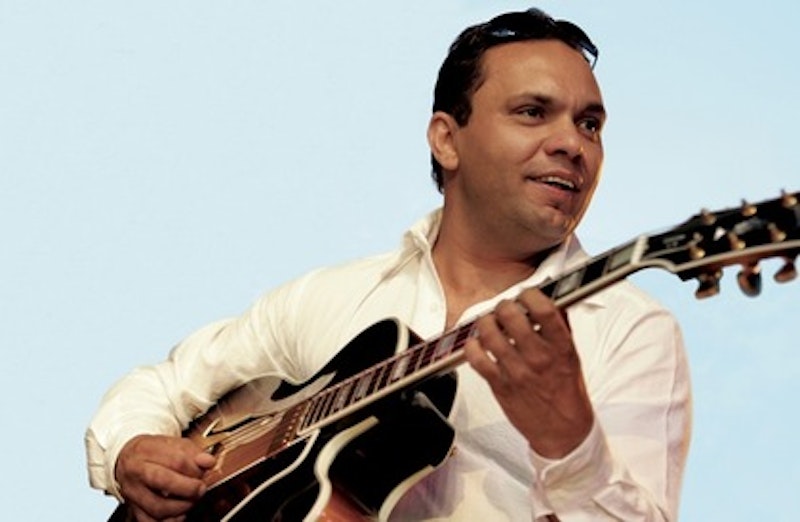Above, Lagrene and a trio ripping it up on the Django standard "Hungaria."
For those of you who’ve never heard of Bireli Lagrene, you’re in for a treat. Though not immediately recognizable in the American scene, Lagrene is widely regarded as one of Europe’s greatest living guitarists, and the inheritor of Django Reinhardt’s rich gypsy guitar (manouche) legacy. Lagrene was born on September 4, 1966 in Alsace, France, the son of Sinti gypsies and much like his hero Django he took to the guitar quite early, realizing he could better his station by wowing the crowds in his traveling caravans with blistering solos, playful tricks and meticulous precision.
For those of us who try to play the guitar, or any string instrument for that matter, it’s easy to see that Lagrene is in a league of his own. I have never seen anyone play the instrument this fast. His use of harmonics alone is revelatory. If scientists could harness the speed of this guy’s fingers, we probably wouldn’t need power plants. But seeing is believing, right? Let’s get to it.
Here he is at 13, solemn and rather tragically buck-toothed Lagrene already playing the prestigious Montreux Jazz festival, where he would appear many times after his career as a gypsy wunderkind fully blossomed. Though his guitar is a bit out of tune at first, (he often will tune in the middle of a solo without missing a beat) it’s easy to tell were big things ahead for young Bireli.
But let’s go back a bit. You can’t talk about Lagrene without knowing a bit about Django himself. Below you can find some great rare sepia-baked footage of the Romani tribes and their caravans where John Baptiste “Django” Reinhardt grew up, including some really nice interviews from the legendary violinist Stephane Grappelli, who formed “The Hot Club Du France” with Reinhardt and helped create some of Reinhardt’s most loved and imitated standards.
As the documentary narrator describes, Reinhardt’s family traveled across Europe and parts of Northern Africa. John was born in Belgium and the family eventually settled semi-permanently outside Paris where the young boy was became fluent on violin, banjo and guitar, recording an LP by the age of eighteen. On November 2, 1928, a fire tore through the rickety wooden gypsy homestead, (his wife made paper flowers in the home, which added to the blaze) badly damaging his right leg and nearly paralyzing the third and fourth fingers of his left hand. With the help of his brother Joseph, also a brilliant guitarist, Django somehow used his handicap to his advantage, creating a nearly unrepeatable style that merged the lightening-quick lines of Franco-gypsy folk with the swinging sentimental strains of American swing and blues. He is buried at Samois Dur Seine, still a hotbed for gypsy culture and music (Lagrene often returns to play there) right next to his brother Joseph.
From a very young age, Lagrene set out to try and recreate the patterns of his hero and definitely seemed to be up to the task. It helped that his father was a Hot Club enthusiast and a popular working guitarist in the 1930s and 40s. Also, like Django, Bireli had a guitar-playing brother who pushed him to get better. “He and I played every day, three or four hours,” Lagrene told an interviewer and by age 10 the precocious Bireli was playing paying gigs had won a prize at a Strasbourg festival. Much like Wes Montgomery had learned how to play Charlie Christian lines note for note, young Lagrene soon was able to ape Django tunes flawlessly, upping his practice schedule to a hellish pace (“I tried very hard every day, eight hours a day”) and in 1980 and ’81 he recorded finger-numbing Django standards that instantly garnered him an enthusiastic following.
“When I was a kid,” Lagrene said, "I used to put on the record again and again, until I succeeded in redoing him [Reinhardt]. Afterwards, I understood that respecting the great guitarist was worth much more than imitating him." Indeed, though Lagrene would be rooted in the traditions of his gypsy past, by the late 1980s and early 90s he would begin to collaborate with fusion artists like Jaco Pastorius (Lagrene is also a fine bass player) and John McLaughlin.
Still it’s his swing and gypsy work that hits the hardest and as the new millennium dawned his label Dreyfus urged Lagrene to return to his roots. The Gypsy Project (2002) is where I (and much of the general listening public) first found Lagrene and features exemplary work from guitarists Thomas Dutronc, "Hono" Winterstein, and Stochelo Rosenberg along with incredible Romanian violinist Florin Niculescu who nearly steals the show himself.
This may be my favorite cut of Lagrene—an epic, breathless (though ever-grinning) duel between Lagrene and Niculescu on “Sweet Georgia Brown” performed at the Vienna Jazz festival. Watch for the effortless melding of blues and gypsy patterns in the nearly three-minute back and forth between fiddle and guitar. If the moment when Lagrene and Niculescu come together in a mirroring solo doesn’t get your blood pumping, you may not have a pulse.
This is another favorite. In the Hot Club tradition, here’s a rip-roaring back and forth between a nearly giggling Lagrene and an equally enthralled violinist on Gershwin’s “I Got Rhythm.” The palpable joy is really something to see.
For more info on the artist, his discography and more, check out his website.
His newest release is Gypsy Routes, a two-disc re-exploration of traditional jazz. Make it your New Year’s resolution to hear this music.

